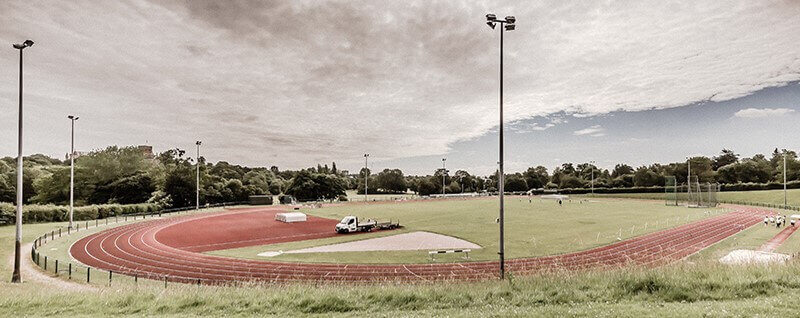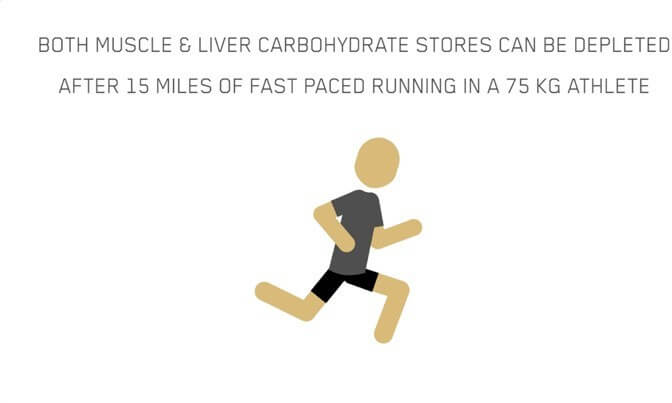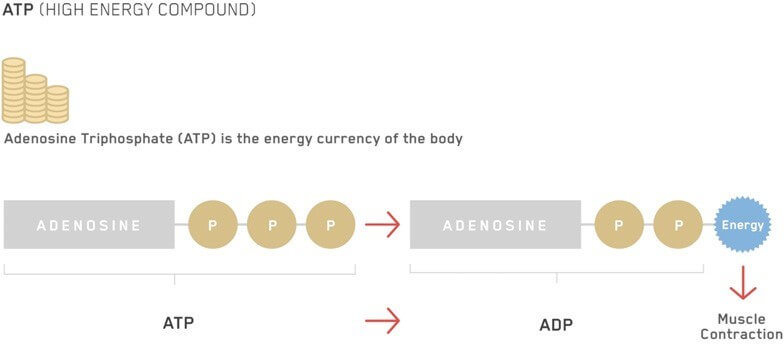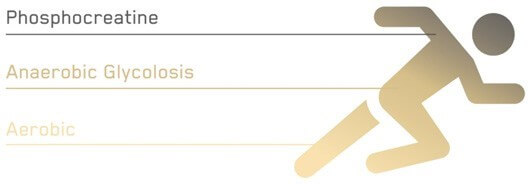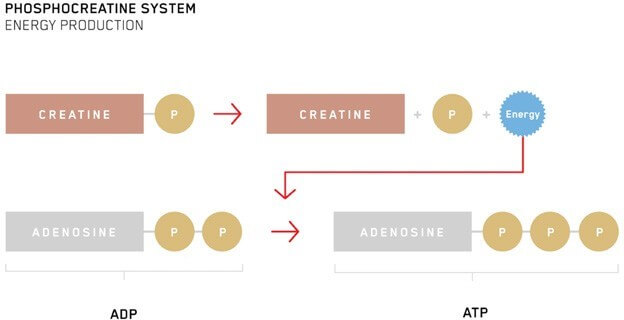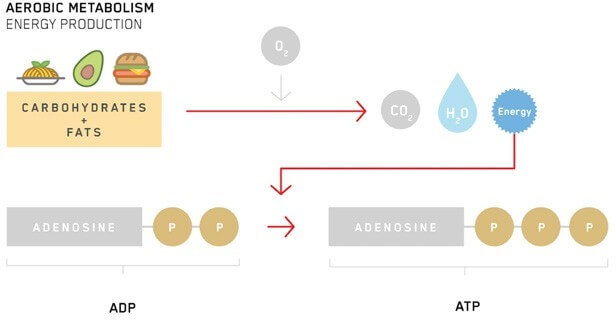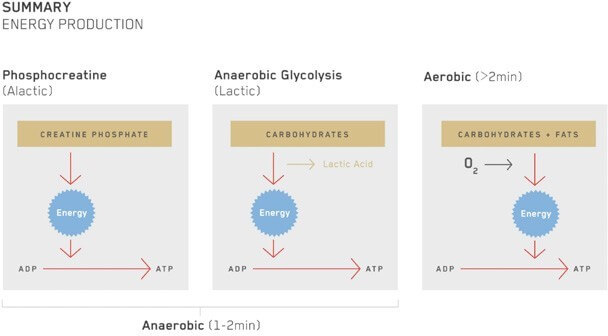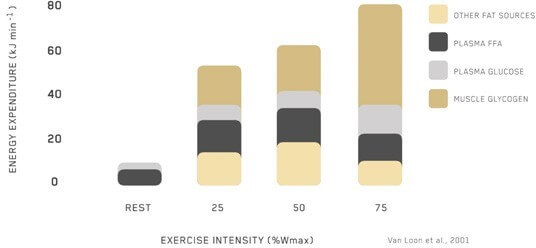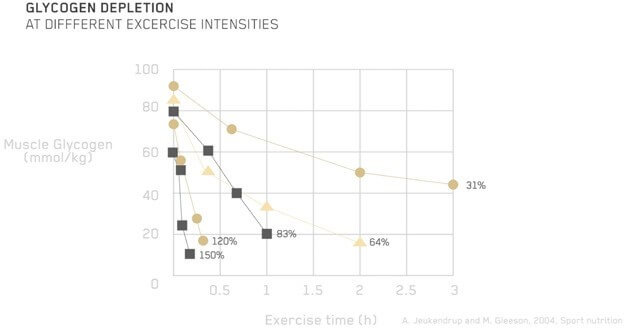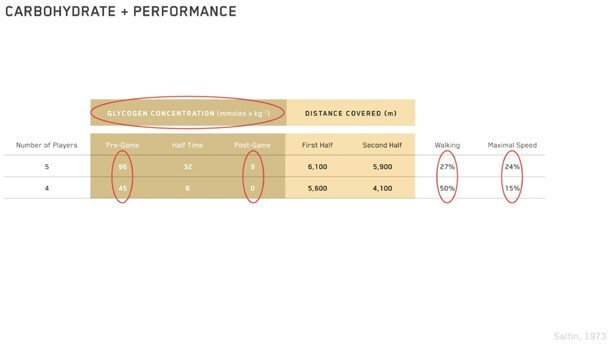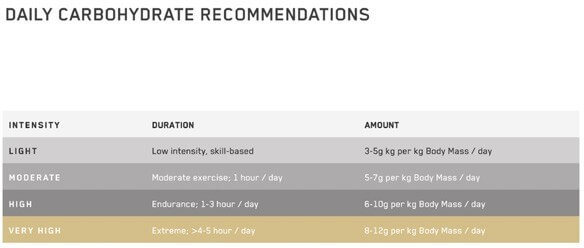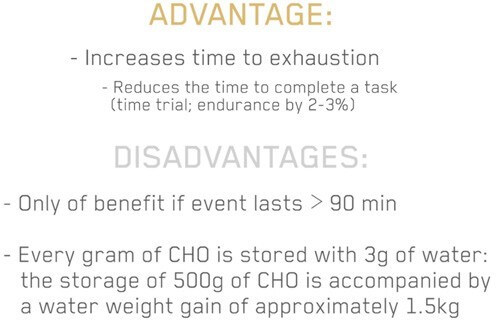The physical demands of the sport will dictate the nutritional recommendations
- Macronutrient requirements will depend on the intensity of the sport
- Understanding the energy demands of the sports allows for more specific recommendations
ATP – Adenosine Triphospate
- Adenosine Triphosphate (ATP) is the energy currency of the cell and is broken down to produce energy
- There is only a small store of ATP within the muscle that needs to be replaced to support exercise needs
- ATP gets broken down to Adenosine Diphosphate (ADP) during exercise
- ATP then needs to be continuously regenerated through different energy systems within the body, mainly phosphocreatine (PCr), carbohydrate/ glycogen and/or fat as a fuel source
- The energy systems of the body are either aerobic or anaerobic
- Aerobic energy systems need oxygen to breakdown fuel sources to produce ATP
- Anaerobic systems can breakdown fuel sources without oxygen
- Carbohydrates can be broken down either aerobically or anaerobically
- Fats are broken down aerobically
THE PHOSPHOCREATINE SYSTEM
- The phosphocreatine molecule is made up of 1 creatine molecule and 1 phosphate molecule
- Once the bond is broken between the creatine and phosphate The phosphate molecule can be donated to Adenosine Diphosphate to become Adenosine Triphosphate
- PCr can only provide energy for up to 3-5 seconds of exercise
ANEROBIC METABOLISM
- Carbohydrate is broken down to carbon dioxide (CO2), water (H2O) and ATP through a series of chemical reactions without oxygen for immediate energy for high intensity exercise lasting up to 90 seconds
- Both glycogen and blood glucose are used as fuel
- Lactic acid is a by-product of anerobic glucose metabolism
- The production of lactic acid is essential for the continued supply of ATP as energy to sustain high intensity exercise
AEROBIC METABOLISM
- The aerobic energy system involves the breakdown of both carbohydrate and fat into CO2, H2O and ATP
- Both sets of reactions use oxygen and provide a slower energy release than the anaerobic system
ENERGY CAPACITY OF THE ENERGY SYSTEMS
- The aerobic energy system has an unlimited capacity to produce ATP compared to the anaerobic system and is the main energy system during sustain/prolonged exercise
- The contribution of energy from the aerobic or anaerobic energy system depends on the intensity and duration of the exercise, nutrition status and fitness of the individual
- The more intense the exercise the more the anaerobic energy system will be used
- The more prolonged the exercise is, the more the aerobic system will be used
Its important to note that all 3 energy systems are switched on during all exercise intensities
- But one energy system will predominate over the others
CARBOHYDRATE & PERFORMANCE
- CHO is an essential substrate for almost all metabolic processes
- CHO is stored as glycogen
- CHO is increasingly important with greater exercise intensity
- Can provide more energy per unit of time than fat
- Depleted within 90 min of intense exercise
Carbohydrate Fuels High Intensity Activity; Sprinting, Jumping, Shooting, Scoring, Tackling, Boxing, Lifting
Glycogen Levels Play a Significant Role in the Athletes’ Ability to Maintain Performance in Sports Lasting Longer than 60min
Carbs Storage
- There are 3 Main Storage Sites for Carbohydrate:
- As Glycogen in the Muscle & Liver
- As Blood Glucose in the Bloodstream
- The Amount of CHO Stored Depends on:
- Nutritional Status
- Training Practices
- Body Size & composition
Factors effecting Utilisation
- Intensity
- Duration
- Level of Training
- Initial Muscle Glycogen Stores
- CHO Supplementation During Exercise
Fuels used during Exercise
- When fasted, as the intensity increases above 70% VO2max carbohydrate metabolism predominates over fatty acids in the production of energy for the contracting muscle
- When exercise is performed at a lower intensity in the fasted state fat predominates over carbohydrate, with its highest contribution at roughly 55% of maximum work
Glycogen depletion during Exercise
The higher the intensity of exercise the faster muscle glycogen is depleted
Carbohydrates for Sports Performance
- Scandinavian scientists studied muscle glycogen metabolism associated with prolonged exercise with the introduction of the needle biopsy in 1960s
- This research found that both carbohydrate infusion during exercise and carbohydrate diets preceding exercise, improved performance when glycogen concentrations were low or deplete
- With a high CHO diet, the time to exhaustion was 3 times greater than a diet of only protein and fat
Research has found that players with greater starting glycogen levels performed more high speed runs and walked for almost 50% less time that players with lower levels. (Saltin, 1973)
- The daily CHO intake guidelines set by the government (50%) cannot be used when working with athletes due to a large individual variance in body composition and activity levels
- Guidelines should:
- Be calculated using body mass and activity level
- Include per kg of bodyweight recommendations
- Amount should optimise fuelling and recovery to:
- Restore muscle glycogen
- Replace energy expended
- Daily CHO intakes should be recommended based on the activity for that particular day
- Light activities may include gymnastics or aesthetics training
- Very high activity may be an endurance athlete training up to 4-5 hours per day
Pre event Intake
- Aim: Top up muscle and liver glycogen stores
- Loading is only necessary if event is >90 min
- Meal timing prior to exercise should be practiced in training to prevent gut issues
- Based on athlete preference
- If CHO supplements are provided ensure sources available are safe for consumption
- Last meal before an event should be low GI if CHO ingestion during an event is restricted
During Event
- Research has found that if CHO is digested during an event the GI of the meal before is irrelevant
- If an event is less than 75 minutes there is no need to ingest CHO during the event provided adequate CHO intake prior to the event
- Carbohydrate mouth rinsing during an event may be beneficial to performance
Carbohydrate Mouthrinse
- Mouth rinsing a CHO containing drink for 10 seconds may improve performance
- This may be due to a brain signalling effect
- Brain receptors are receptive to carbohydrates and not sweetness
- Mouth rinsing may reduce the Rate of Perceive Exertion (RPE) and allow athletes exercise at a higher intensity
- Trial in training
- Rinse for 5-10 Seconds Routinely
- Improve High Intensity Performance Lasting 30-70 minutes
- Who to use it with
- GI Distress
- Weight Management
Fasted Exercise
- Muscle contraction during exercise changes the concentration of specific energy sensing proteins that are found within skeletal muscle
- Low carbohydrate situations increase metabolic stress within the cell and may have a similar effect to fasted training on these proteins
- Fasted training may increase certain enzymes that promote increased fat oxidation
- Fasted training may improve training adaptations
- Research has found no difference between fasted or fed exercise on fat loss when calories are matched
Summary
Energy Systems
- PCr
- Is the Most Rapidly Available Source of ATP for the Muscle
- Capacity is Very Limited – Depleted Following 3-5 sec of All Out Exercise
- Anaerobic System
- Breaks Downs Carbohydrate without the use of O2 to form ATP with Lactic Acid as a by Product
- Predominants for 60-90 sec of high intensity exercise
- Aerobic System
- Breaks Down Carbohydrate & Fat to Produce ATP with the use of O2
- Has a Large Capacity for ATP Production (Constant & Never Ending)

